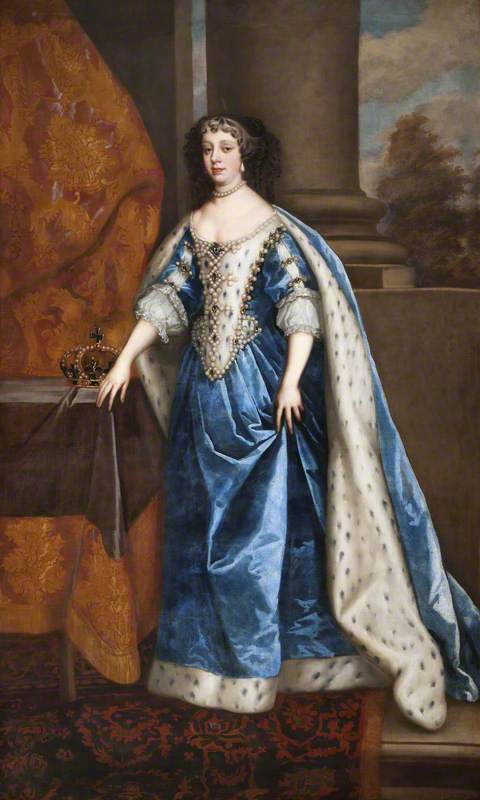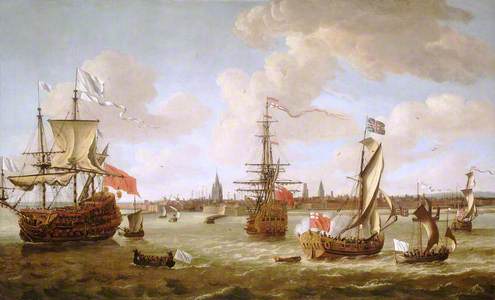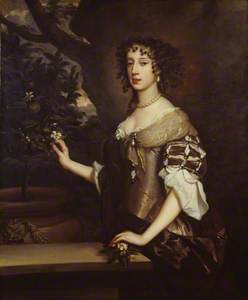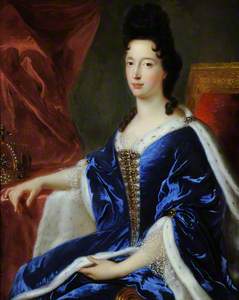Mary of Modena was born Maria Beatrice d'Este on 6th October 1658, the only daughter of Alfonso IV and Laura Martinozzi (one of the seven famously beautiful nieces of Cardinal Mazarin). From her earliest years, her greatest wish was to become a nun and to join the convent attached to the palace, where she had received a thorough education – equal to that of her brother.
But when, in England in 1670, Anne Hyde, wife to James, Duke of York (1633–1701), died of breast cancer, it was not long before a new bride was sought for the heir to England's throne. Charles II's (1630–1685) marriage to Catherine of Braganza (1638–1705) had borne no children, and his brother James would need a dynastic match to a European princess.

Image credit: Government Art Collection
Duke of York (1633–1701) (later King James II)
John Michael Wright (1617–1694)
Government Art CollectionMaria of Modena was the chosen candidate. And though she protested that she would rather throw herself into the fire than marry, she had no real choice. When the Pope wrote to her telling her of her duty, Maria screamed and cried for three days and had to be held down by force, but she could not disobey a papal command. When James learned that the proxy marriage had taken place, he told his 11-year-old daughter Mary that 'he had found a play-fellow' for her.
In October 1673, on her fifteenth birthday, Maria left her home of Modena and began the long journey through Italy and France to take her place as Duchess of York and future Queen of England. The end of this journey from Calais to London was documented in sketches by court painter Willem Van de Velde the elder (1633–1707). In this sketch, we see the embarkation at Gravesend, where Maria was met by Charles II – the larger barges in the middle of a small fleet carry the monarch and the newly wedded couple.

Image credit: The Fitzwilliam Museum
Mary of Modena Embarking at Gravesend (26 November 1673) 1673
Willem van de Velde I (1611–1693)
The Fitzwilliam MuseumAnd in this later image, we can see a full painting by Jacob Knyff (1639–1681) showing the great ships (known as yachts) sailing out of the port of Calais. The crossing was rough, and we see here the waves buffeting the smaller boats, as sails billow in the winds.

Image credit: National Maritime Museum, Greenwich, London
Mary of Modena (1658–1718) Leaving Calais, 21 November 1673
Jacob Knyff (1639–1681)
Royal Museums GreenwichWhen she arrived in England, one of the first things she did was have her portrait done by the court painter Peter Lely (1618–1680). This was something of a rite of passage, but also marks the way that Maria would take on the mantle of patron of the arts. The Estes were a family who understood the power of art and display. In Ferrara and Modena, they had been patrons of Tasso, Ariosto, Tintoretto and Boulanger, and she could boast the great Isabella d'Este (1474–1539) – patron of Da Vinci, Titian, Mantegna, Bellini and Raphael – among her ancestors.
Lely seems to have taken this lineage to heart in this commission. Usually, his paintings were created by his studio, and he would add the important parts and do the finishing touches, but this portrait is almost entirely created by his own hand. The painting is as thoughtful as it is fashionable. Maria's clothes are in vogue in a style of loose 'undress', though Lely already knew enough about his sitter to paint her with a little more propriety than other court women exhibited. Her hair falls in gentle ringlets around her face and down her shoulder.
As she stands in three-quarter profile, looking out at the viewer, she reaches out with her right hand to pick a delicate orange blossom; a symbol of innocence, virtue, and purity often used in images of young brides. The pearl that hangs on her dress just in front of her heart speaks of her virtue.
Though her initial meeting with James on the beach at Dover had not been a success – James grabbed her in an embrace; she had burst into tears – he was kind and she grew to love him. Within the first year of their marriage, Maria was already pregnant, though she miscarried after a few months. This was the first of many heartbreaking disappointments for Maria and James. In 1675, Maria gave birth to a daughter, named Catherine Laura after the Queen and the Duchess of Modena, but this child lived only ten months. The distress at losing her daughter caused Maria to suffer another miscarriage.
The next child, Isabella, lived long enough to have her portrait painted by Lely. It is a sweet image probably painted when she was around three years old. She sits on regal robes petting a lamb, thereby symbolising her innocence. But there is something touchingly human about this work; the lamb indulgently narrows its eyes whilst the princess tugs at its ears. Isabella died in 1681 at the age of four.

Image credit: Government Art Collection
Princess Isabella (1676–1681), Daughter of James II and Mary of Modena c.1679–1681
Peter Lely (1618–1680) (after)
Government Art CollectionIn her early years, Maria attended the many entertainments the court had on offer, and she would contribute to its artistic scene by commissioning a court masque, thereby resurrecting a royal tradition that had reached its pinnacle under Charles I. This masque was cast predominantly using the young women of the court, with her stepdaughters, Princess Mary and Princess Anne, taking leading roles. They acted alongside Sarah Jennings (later Churchill) (1660–1774), who at this time was the favoured maid of honour to Maria, but who would later betray her by joining William III (1650–1702) and Mary II (1662–1694) in the Glorious Revolution, and who would become the great favourite of Queen Anne (1665–1714).

Image credit: Government Art Collection
Sarah, Duchess of Marlborough (1660–1744), Politician and Courtier
Charles Jervas (c.1675–1739)
Government Art CollectionWhen Maria lived in the convent in Modena, she had grown up in an environment of female learning, and she sought to replicate this life – as far as she could – among the women of her court. This masque is an early example of her patronage of the women around her, a patronage which would reach its pinnacle in the 1680s, when Anne Killigrew (1660–1685) and Anne Kingsmill (later Finch) (1661–1720) joined her household as maids of honour. Together they would read Tasso and Ariosto, and possibly study Latin and Greek.
In a world in which women had little access to education, and those of this class were raised to be purely decorative, Maria made a new world which encouraged women's education and artistic production.
One of the fruits of this patronage would also take the form of a court masque: the opera, Venus and Adonis, the libretto of which it is now thought was written by Kingsmill, perhaps in collaboration with Killigrew. Both of these women were budding poets, but Killigrew was also an artist, and she painted a set of works to accompany this entertainment, which was performed in 1684, the year before her tragic death from smallpox when she was just 25.

Image credit: The Trustees of the British Museum, CC BY-NC-SA 4.0
Venus and Adonis
c.1674–1725, mezzotint on paper by Bernard Lens II (1659–1725) after Anne Killigrew (1660–1685)
From her earliest days at court, Maria was likened to the goddess Venus, particularly in poetry, and we see references to this littered throughout the verses written to celebrate her coronation in 1685. Aphra Behn (1640–1689) wrote of her appearance that 'So Venus look't when from the Seas / The rising Beauty view'd the world' in A Pindarick Poem on the Happy Coronation of His Most Sacred Majesty James II and His Illustrious Consort Queen Mary. But what is striking about this poem is the image which comes next:
And now the Nymphs ply all their Female arts
To dress Her for Her victory of hearts;
A Thousand little LOVES descend!
Young waiting Cupids with officious care
In smiling order all attend:
This, decks Her Snowy Neck, and that Her Ebon Hair.
The nymphs who 'ply … their female arts' are found in a painting by Killigew, Venus Attired by the Three Graces.
Here we see Venus surrounded by her Graces, her nymphs. One sits at her feet, deep in conversation, ready to place her sandals on her feet, the others stand to her side, one arranging her hair, another holding the belt to the robe that she sits on. This robe is worn by James II in his coronation portrait by Killigrew.

Image credit: Royal Collection Trust / © His Majesty King Charles III 2024
James II (1633–1701)
1685, oil on canvas by Anne Killigrew (1660–1685)
As Behn's nymphs dress Venus 'for her victory of hearts', Killigrew's graces dress her in her husband's coronation robes. Venus and Maria are interchangeable. And Behn must have been familiar too with the operatic masque of Venus and Adonis, for the 'young waiting cupids' who 'deck her snowy neck' and 'ebon hair' are found doing just that in Kingsmill's libretto. These women then either collaborated or referenced each other's work in this moment, when Maria became their Queen.
In this portrait, made upon her accession as Queen, Willem Wissing (1656–1687) gestured towards this when he painted her hair flowing down her shoulders, as Venus was depicted. This portrait was made several times, sometimes featuring a loyal dog, other times a cockatoo, to demonstrate her colonial interests.

Image credit: National Galleries of Scotland
Mary of Modena (1658–1718), Consort of James VII and II 1687
Willem Wissing (1656–1687)
National Galleries of ScotlandBut this moment did not last long. Though James's reign began well, relations between the new King and Parliament soon broke down. The great fear that he would turn England back to Catholicism was never far away, and when James began to give important political positions to Catholics, this fear was fed. But as long as he did not have a son, and Mary over in Holland remained his Protestant heir, he continued to walk his tightrope. Between 1678 and 1680 the York household were sent away into exile, when the Popish Plot of Titus Oates reared its ugly head.
But in June 1688, amidst rumours fuelled by Princess Anne that the pregnancy was a hoax, Maria gave birth to the longed-for and feared-for son, James Francis Edward Stuart (1688–1766). This was Maria's eleventh pregnancy, though she had no living children to show for it. He was baptised in October, the first time a royal baby was baptised a Catholic since Princess Mary (late Mary I) in 1516, and the first time a Prince of Wales was baptised a Catholic since Henry VIII in 1491.

Image credit: National Galleries of Scotland
Prince James Francis Edward Stuart (1688–1766), Son of James VII and II 1691
Nicolas de Largillière (1656–1746)
National Galleries of ScotlandFrom Parliament's perspective, the worst had happened, and seven prominent men (later known as the Immortal Seven) wrote to William III, inviting him to invade England. He arrived at Brixham with a huge fleet on 5th November 1688. When James's favoured courtier, John Churchill, and his son-in-law, George of Denmark, abandoned him on the battlefield to join William's army, all hope of winning was gone. And he soon found that his daughter Anne had left him too, with her favourite (and previous maid of honour to Maria), Sarah Churchill. He sent Maria and his son into exile in France, and said he would join them soon.

Image credit: public domain (source: Wikimedia Commons)
Queen Mary of Modena with Prince James Stuart
1690s, oil on canvas by Benedetto Gennari II (1633–1715)
On Christmas Eve, Maria landed once again on the shores of Calais, just 15 years after she had left them to become Duchess of York. She had just her child and a few of her loyal women with her. James joined her soon afterwards. Though William protested that he was there to hold James to account rather than to take the crown, it was inevitable that he and his wife, James's daughter Mary, would become King and Queen of England, and their coronation took place on 11th April 1689.
In Mary's coronation portrait, there are striking similarities in dress and expression to one made for her stepmother some four years earlier. Both were painted by the court artist Godfrey Kneller (1646–1723) – perhaps he made over the designs along with his loyalties.
In exile, James and Maria did not give up hope of regaining their crown, and they used the power of art to continue to demonstrate their royal rights. In this image, Maria wears velvet royal blue, and the crown is prominently beside her; she is just waiting to wear it once again.

Image credit: National Trust Images
Queen Mary of Modena, Princess Maria Beatrice d'Este (1658–1718) 1698
François de Troy (1645–1730)
National Trust, Sizergh CastleIn this family portrait by Pierre Mignard (1612–1695), dated 1695, the couple sit in their royal regalia. To the side of Maria stands James Francis. He is only seven years old, but he stands like a royal prince. Both he and Maria point their hands down to the floor, to a crown that rests there. The message is clear: he is the heir to the throne of England; it is his crown.
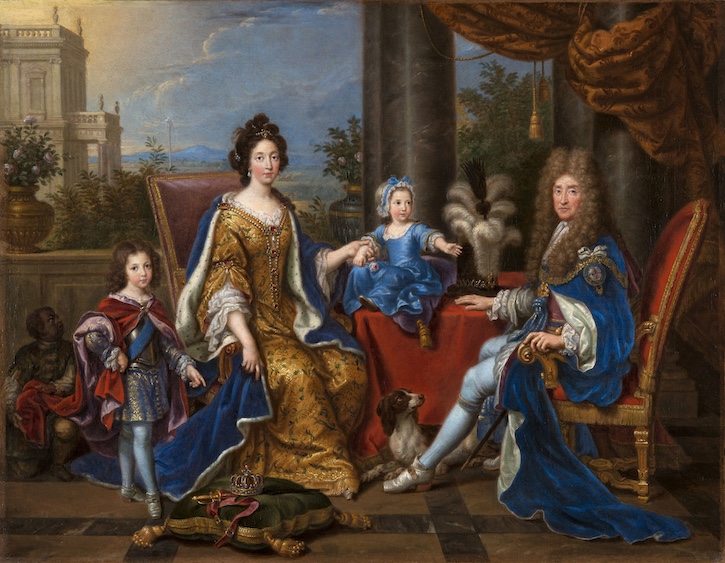
Image credit: Royal Collection Trust / © His Majesty King Charles III 2024
The Family of James II
1694, oil on canvas by Pierre Mignard (1612–1695)
And dating from a similar time, we see the prince standing alone, painted as a Roman emperor, though he is only a child. When he was older, he would indeed take up arms to fight for his crown, but he would not be successful.

Image credit: National Trust Images
James Francis Edward Stuart, 'The Old Pretender' (1688–1766), as Prince of Wales 1690–1700
Jacob van Schuppen (1670–1751) (attributed to)
National Trust, Sizergh CastleWhen Mary died in 1684, the family hoped they might be invited back, but these hopes were in vain. They lived the rest of their lives in France, at the Palace of St Germain-en-Laye, under the generous hospitality of Louis XIV. But for Maria, life came full circle, as she became the patron of the convent of the Order of the Sisters of the Visitation, the same order she had hoped to join as a child. She was buried in the convent in 1718.
Breeze Barrington, cultural historian specialising in the seventeenth century
Breeze's first book, The Graces, about Maria of Modena and the community of female learning she cultivated within the Jacobite court, will be published by Bloomsbury in July 2025
This content was funded by the Samuel H. Kress Foundation












